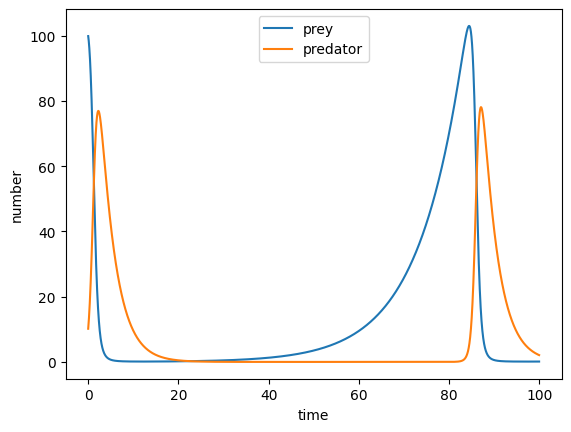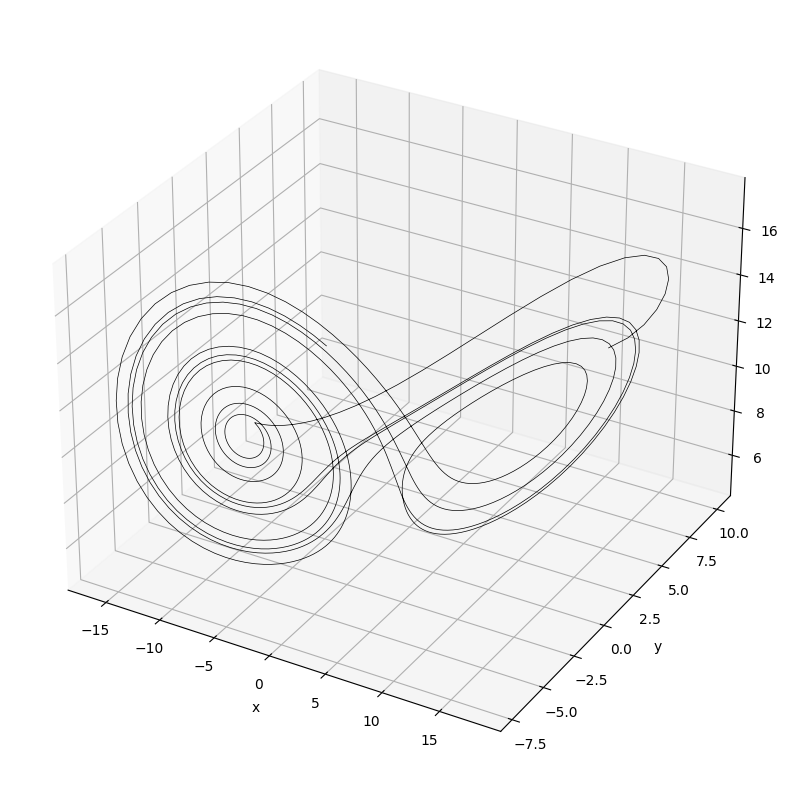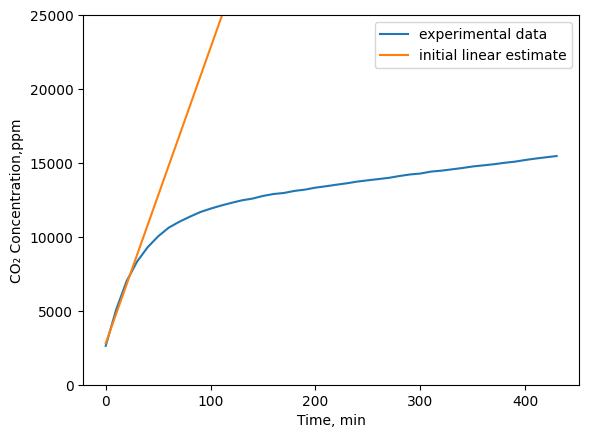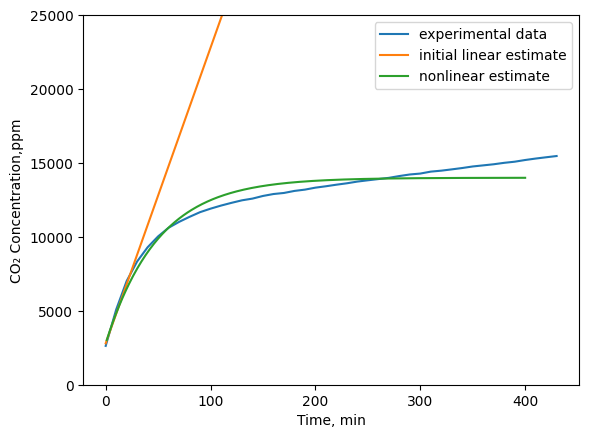12 - More ODEs#
Non-steady state scenarios occur all around us: heating up your cold hands, warming up your food, filling your washing machine, among a myriad of other examples. There’s also many non-steady state scenarios in chemical engineering: filling a tank, heating up a reactor, cooling down a reactor, etc. In this lecture, we will get more practice setting up problems and estimating a solution.
You should further understand at the end of this discussion that if you have an expression for the derivative, you can integrate that numerically to determine the system parameters as a function of time.
First Example: Predators and Prey#
We know that predators and prey are related. If there are more prey, there will be more predators. If there are more predators, there will be less prey. This is a classic example of a coupled system. We can write a differential equation for the number of prey and predators as:
where \(P\) is the number of prey, \(C\) is the number of predators, \(a\) is the growth rate of prey, \(b\) is a coupling parameter, and \(c\) is the death rate of predators.
#this calculates the number of predators and prey in a given time interval
#and plots the results
import numpy as np
import matplotlib.pyplot as plt
#initial conditions
prey = 100
predator = 10
a = 0.1
b = 0.02
c = 0.3
t = 0
dt = 0.01
tmax = 100
#arrays to store the results
prey_array = np.zeros(int(tmax/dt))
predator_array = np.zeros(int(tmax/dt))
time_array = np.zeros(int(tmax/dt))
#loop over time
for i in range(int(tmax/dt)):
#calculate the derivatives
dprey = a*prey - b*prey*predator
dpredator = -c*predator + b*prey*predator
#update the variables
prey += dprey*dt
predator += dpredator*dt
#store the results
prey_array[i] = prey
predator_array[i] = predator
time_array[i] = t
t += dt
#plot the results
plt.plot(time_array,prey_array,label='prey')
plt.plot(time_array,predator_array,label='predator')
plt.xlabel('time')
plt.ylabel('number')
plt.legend()
plt.show()

Do you see that oscillatory pattern between predators and prey in nature?
Second Example: Solving the Lorenz Equations#
The Lorenz equations are a set of three coupled, non-linear differential equations. They are used to model convection in the atmosphere and were developed by Edward Lorenz in 1963. Below is an example implementation of one solution to the Lorenz equations which are:
where \(\sigma\), \(\rho\), and \(\beta\) are constants and are proportional to the Prandtl number, Rayleigh number, and other dimensional specific relations. \(x\) is proportional to the convection rate, \(y\) the horizontal temperature variation, and \(z\) the vertical temperature variation.
import numpy as np
sigma=10; rho=28; beta=8/3
#function to calculate the derivatives
def lorenz(x, y, z):
dx = -sigma * x + rho * y
dy = x * sigma - y - x*z
dz = x*y - beta * z
return dx, dy, dz
x0, y0, z0 = 10, 10, 10
dt = 0.01
t = np.arange(0, 10, dt)
#arrays to store the results
x, y, z = np.zeros_like(t), np.zeros_like(t), np.zeros_like(t)
x[0], y[0], z[0] = x0, y0, z0
for i in range(1, len(t)):
dx, dy, dz = lorenz(x[i-1], y[i-1], z[i-1])
x[i] = x[i-1] + dx*dt
y[i] = y[i-1] + dy*dt
z[i] = z[i-1] + dz*dt
#now plot the results
from mpl_toolkits.mplot3d import Axes3D
import matplotlib.pyplot as plt
fig = plt.figure(figsize=(10, 10))
ax = fig.add_subplot(projection='3d')
ax.plot(x, y, z, lw=0.5, color='black')
ax.set_xlabel('x')
ax.set_ylabel('y')
ax.set_zlabel('z')
plt.show()

Third Example: Carbon Dioxide Concentration#
Carbon dioxide (\(CO_2\)) is produced by decaying organic matter. \(CO_2\) is consumed by photosynthesis processes. Below is a photo of a sealed terrarium.
If there are no plants in the terrarium, the \(CO_2\) concentration will increase over time. One estimate is it will increase at a constant rate according to the following differential equation:
where \(C_{CO_2}\) is the concentration of \(CO_2\) in the terrarium (ppm) and \(k\) is the rate constant (1/time unit). This is a zero-order differential equation. The rate constant is proportion to the amount of soil decaying in the terrarium.

Given the above differential equation: \(dC_{CO_2}/dt = k\), we can integrate both sides to obtain the concentration as a function of time easily by doing the integration analytically to yield:
where \(C_0\) is the initial concentration of \(CO_2\) in the terrarium.
import numpy as np
time_min = np.arange(0, 400, 1)
lin_co2 = 200*time_min + 2800 #initial estimate with k and CO2 at 2000 ppm
Now we’ll compare that linearly increasing predicted rate to a real scenario of carbon dioxide concentration inside a small terrarium. The atmosphere of the terrarium is first blown out with air and then it is completely closed with no plants present. Data was collected with a Bluetooth CO2 SCD30 monitor and an ESP32 microcontroller.
#import needed packages
import pandas as pd
#read in the data
df = pd.read_csv('https://github.com/clint-bg/comptools/raw/main/lectures/supportfiles/co2concterr.txt', sep='\t', header=9)
df.tail()
| Epoch_UTC | Local_Date_Time | T | RH | CO₂ | DP | AH | HI | MR | |
|---|---|---|---|---|---|---|---|---|---|
| 61459 | 1.687909e+09 | 2023-06-27T17:42:19.779569 | 27.572 | 90.44 | 15974.0 | 25.864 | 23.97 | 32.807 | 21.402 |
| 61460 | 1.687909e+09 | 2023-06-27T17:42:19.861700 | 27.572 | 90.44 | 15974.0 | 25.864 | 23.97 | 32.807 | 21.402 |
| 61461 | 1.687909e+09 | 2023-06-27T17:42:19.865171 | 27.572 | 90.44 | 15974.0 | 25.864 | 23.97 | 32.807 | 21.402 |
| 61462 | 1.687909e+09 | 2023-06-27T17:42:19.943573 | 27.572 | 90.44 | 15974.0 | 25.864 | 23.97 | 32.807 | 21.402 |
| 61463 | 1.687909e+09 | 2023-06-27T17:42:19.947163 | 27.572 | 90.44 | 15974.0 | 25.864 | 23.97 | 32.807 | 21.402 |
#add an extra column to the dataframe that is the seconds from the start of the data from the
# Epoch_UTC column, use pandas date time package to convert from year-month-dayThour:minute:second to minutes
df['min'] = pd.to_datetime(df['Local_Date_Time'], format='%Y-%m-%dT%H:%M:%S.%f').astype(int)/1e9/60 #min
#now reference from the start of the data
df['min'] = df['min'] - df['min'].iloc[-594]
df.iloc[-594]
Epoch_UTC 1687880366.8
Local_Date_Time 2023-06-27T09:39:26.827185
T 25.801
RH 92.05
CO₂ 2627.0
DP 24.41
AH 22.113
HI 26.84
MR 19.572
min 0.0
Name: 60870, dtype: object
#plot the last custom amount of rows in the dataframe for the CO2 column
import matplotlib.pyplot as plt
plt.plot(df['min'].iloc[-594:-550],df['CO₂'].iloc[-594:-550], label='experimental data')
plt.plot(time_min,lin_co2, label='initial linear estimate')
plt.xlabel('Time, min'), plt.ylabel('CO₂ Concentration,ppm')
plt.ylim(0, 25000)
plt.legend(); plt.show()

As can be seen above, our initial linear estimate isn’t very accurate. It appears that the production rate of CO2 is is initially at a constant rate and then at a certain concentration, it changes to a different rate. Perhaps a more accurate model would be:
#integrate the below function symbolically with sympy
import sympy as sym
sym.init_printing(use_unicode=True) #for pretty printing
C = sym.Function('C')
t = sym.symbols('t')
k1,k2 = sym.symbols('k1, k2')
sym.dsolve(sym.Eq(C(t).diff(t), k1 - k2*C(t)), C(t))

def Coft(t, C1, k1, k2):
return (k1/k2)*(1 - C1*np.exp(-k2*t))
time = np.linspace(1,400,400)
Con = Coft(time,0.8,280,0.02)
#plot the values
plt.plot(df['min'].iloc[-594:-550],df['CO₂'].iloc[-594:-550], label='experimental data')
plt.plot(time_min,lin_co2, label='initial linear estimate')
plt.plot(time,Con,label='nonlinear estimate')
plt.ylim(0, 25000)
plt.legend(); plt.xlabel('Time, min'), plt.ylabel('CO₂ Concentration,ppm')
plt.show()

From this, it looks like the the dependenc of the rate of CO2 production is dependent on the concentration of CO2 in the terrarium but perhaps it’s not as strong as a first order relationship. Maybe a better approximation is:
You can see if that’s a better fit to the data in a similar way I did above.
The above plot shows that the non-linear estimate (with parameters that were manually adjusted to better fit the data) is close to the actual data. Instead of manually adjusting the parameters, how could we estimate the parameters automatically? We could use a least squares approach to estimate the parameters. We’ll discuss that in the next lecture.

